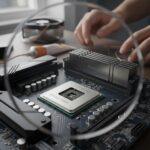The tech world is abuzz with rumors about AMD’s upcoming Ryzen 9 9950X3D2 CPU, a fascinating yet controversial new chip design. This processor is said to feature dual chiplets with 3D V-cache technology, promising unprecedented cache size and performance. However, despite the excitement, there are valid reasons to approach this rumored CPU with skepticism. Let’s explore what this 9950X3D2 could mean, the trade-offs it entails, and why some experts believe it’s not the ideal path forward.
The Evolution of AMD’s Chiplet Design
Since launching the first Ryzen processors in 2016, AMD has embraced a chiplet architecture, segmenting CPUs into smaller core complexes (CCD) connected via Infinity Fabric. Typically, each CCD contains up to 8 cores and 16 threads, and AMD has gradually increased core counts by adding more chiplets. This scalable design allows flexible core configurations while managing manufacturing yields and costs.
The introduction of 3D V-cache technology marked a significant leap, stacking large amounts of L3 cache atop the cores to dramatically enhance gaming performance and latency-sensitive workloads. Current high-end CPUs like the Ryzen 9 7950X3D feature one CCD with 96MB of 3D V-cache, paired with another CCD designed for higher clock speeds but with less cache, resulting in an asymmetrical setup optimized for mixed workloads.
What Exactly is the Ryzen 9 9950X3D2 Rumor?
The rumored 9950X3D2 aims to push boundaries further by combining two CCDs, each equipped with 3D V-cache, effectively doubling the L3 cache to 192MB. Built on the Zen 5 architecture, it reportedly sports 16 cores and 32 threads with base clocks around 4.3 GHz and boost clocks up to 5.6 GHz. The power draw is expected to increase to a 200-watt TDP from the current 170 watts of the 9950X3D.
Theoretically, having both chiplets with expanded cache could improve gaming frame rates, reduce performance dips, and boost productivity in cache-sensitive applications. Industry experts anticipate around 10-15% improvements in gaming performance compared to the existing 9950X3D, reinforcing AMD’s dominance in this space.
Concerns: Latency, Power, and Practicality
Despite these promising specs, there are some inherent challenges. First is the latency penalty between the two chiplets (CCDs). Even with AMD’s advances in Infinity Fabric interconnect speed, communication between different CCDs introduces delays that reduce the benefits of larger cached data pools. In gaming, where milliseconds count, these cross-chiplet latencies can cause bottlenecks, undermining the advantages of dual large caches.
Moreover, increasing the TDP to 200 watts raises thermal and power consumption concerns. Such power demands require superior cooling solutions and could limit usability in compact or energy-conscious setups.
From a manufacturing perspective, the cost and complexity of producing dual 3D V-cache CCDs are significant. These chips are expensive to fab, and expanding cache sizes exponentially increases die area, affecting yields and pricing. Thus, the 9950X3D2 could become prohibitively expensive and niche-focused.
Why an Asymmetrical Design Still Makes Sense
AMD’s current asymmetrical approach—pairing one high-cache CCD with another high-frequency, lower cache CCD—balances gaming performance and multitasking efficiency effectively. This design minimizes cross-chiplet latency for gaming threads by keeping the game running on the cache-rich CCD, while handling background tasks on the frequency-optimized CCD.
Many experts argue doubling down on 3D V-cache may offer diminishing returns because eliminating latency between chiplets is more impactful than simply adding more cache. The ideal CPU might be a single larger CCD with extended cache, removing inter-CCD latency altogether. However, manufacturing such a large chip poses its own challenges.
Looking Ahead: Balancing Innovation and Viability
While the Ryzen 9 9950X3D2 sounds like a technological marvel, some industry insiders view it as AMD potentially overreaching for marketing and hype rather than delivering a truly balanced product. AMD’s dominant position on the CPU front allows it to experiment, but not every innovation leads to clear user benefits.
Until AMD confirms details and delivers final performance benchmarks, it’s wise to treat the 9950X3D2 rumors with cautious optimism. For gamers and professionals, the current lineup of X3D processors still provides excellent performance with a well-thought-out architecture that prioritizes latency reduction and power efficiency.
In conclusion, the rumored AMD Ryzen 9 9950X3D2 CPU offers exciting prospects with dual chiplets featuring massive 3D V-cache. However, the trade-offs in latency, power, and cost raise reasonable doubts about its practical advantages. The future of high-performance CPUs might better lie in refined single large chip designs than stacking chiplets with duplicative cache. As always, technological evolution is a balance between pushing limits and retaining real-world value for users.






